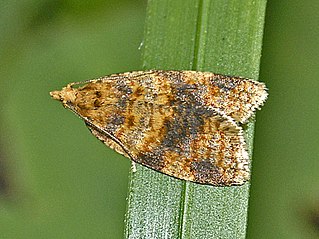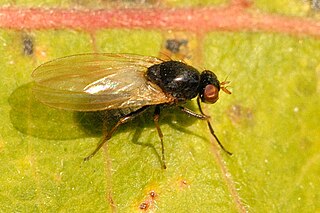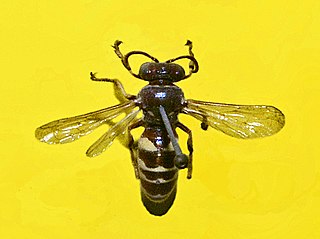
The Scoliidae, the scoliid wasps, are a family of wasps comprising about 560 species worldwide. They tend to be black, often marked with yellow or orange, and their wing tips are distinctively corrugated. Males are more slender and elongated than females, with significantly longer antennae, but the sexual dimorphism is not as apparent as in many of the Tiphiidae and Thynnidae.

Epagoge grotiana, common name brown-barred tortrix, is a moth of the family Tortricidae, first described by Johan Christian Fabricius in 1781.

Brithys crini, the amaryllis borer, crinum borer, lily borer or Kew arches, is a moth of the family Noctuidae. It is a garden pest in parts of its range, as their larvae damage the stems and leaves of lilies, especially lilies of the family Amaryllidaceae.

Elaphrus uliginosus is a species of ground beetle native to the Palearctic realm. It is widespread but rare in Europe, and is absent from much of Southern Europe. It is a wetland and coastal species.

Notiophilus biguttatus is a species of ground beetle native to the Palearctic. It was first described by Johan Christian Fabricius in 1779. Sometimes referred to as the Common springtail stalker

Prochoreutis myllerana, Miller’s nettle-tap or small metal-mark, is a moth of the family Choreutidae found in Asia and Europe. Miller's nettle-tap was first described by Johan Christian Fabricius in 1794 from a specimen found in Sweden.

Myennis octopunctata is a species of picture-winged fly in the genus Myennis of the family Ulidiidae.
Cerobasis annulata is a species of Psocoptera from Trogiidae family that can be found in Austria, Azores, Belgium, Cyprus, France, Germany, Great Britain, Greece, Italy, Luxembourg, Madeira, Norway, Poland, Portugal, Switzerland, and the Netherlands.

Calliopum is a genus of small flies of the family Lauxaniidae.

Stizus fasciatus is a species of sand wasps belonging to the family Crabronidae.

Bembecinus tridens is a species of sand wasps belonging to the family Crabronidae.

Nysson is a Holarctic genus of kleptoparasitic wasps in the family Crabronidae. Over 100 species are known.

Oxybelus is a genus of wasps in the family Crabronidae. The species are found worldwide except in the Australasian realm. They are especially represented in the Palearctic. Oxybelus is the largest genus in Crabronidae, with 264 species known. Oxybelus wasps sometimes gravitate towards people, flying around travellers and landing on them, even when they are shooed away. It is not known why they do it, however it might possibly be them trying to drink sweat for its minerals.

Chrysopilus cristatus, is a species of 'snipe flies' belonging to the family Rhagionidae.

Dialineura anilis is a species of ' stiletto flies' belonging to the family Therevidae. It is a Palearctic species with a limited distribution in Europe

Philonicus albiceps is a species of 'robber fly' belonging to the family Asilidae. It is a Palearctic species with a limited distribution in Europe

Acrosathe is a genus of stiletto flies in the family Therevidae. There are more than 20 described species in Acrosathe.
Acrosathe vialis is a species of stiletto fly in the family Therevidae.
Acrosathe pacifica is a species of stiletto fly in the family Therevidae.
















